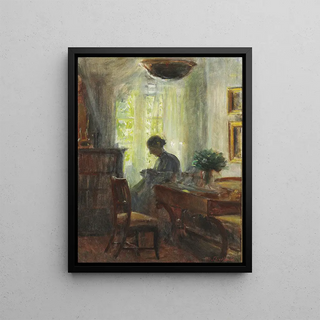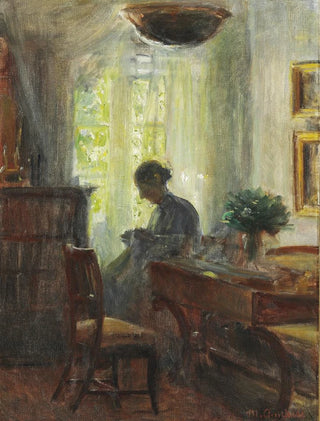Art print | Interior of the artist Mrs. Anna Ancher's house by Sytjet - Michael Ancher


View from behind

Frame (optional)
Introduction captivante
The "Interior of the artist Mme Anna Ancher's house" by Sytjet - Michael Ancher is much more than a simple depiction of an interior space. It immerses us in the artist's intimacy, revealing not only a place of creation but also a universe filled with emotions and stories. This painting, imbued with light and softness, invites the viewer to share a suspended moment in time, where every detail seems to tell a story. The delicacy of the colors and the precision of the shapes testify to an artistic sensitivity that transcends eras, offering a window into the life of a female artist at a time when her role was often underestimated. This work is a celebration of female creativity, a tribute to the passion and devotion that inhabit Anna Ancher's studio.
Style and uniqueness of the work
The uniqueness of this work lies in its intimate approach and its ability to capture the very essence of daily life. Michael Ancher, as an artist, excels in the art of light and shadow, and this is brilliantly demonstrated in this composition. The delicate nuances of the palette, ranging from warm tones to cooler shades, create a welcoming and soothing atmosphere. Everyday objects, carefully arranged, add a narrative dimension to the piece, inviting the viewer to imagine the stories unfolding within this space. The perspective chosen by Ancher allows the interior to be perceived as a living painting, where each element contributes to the overall harmony. This attention to detail, coupled with undeniable technical mastery, gives the work a rare emotional depth, transforming a simple interior into a true sanctuary of art.
The artist and his influence
Michael Ancher, an emblematic figure of the Danish painters' movement in Skagen, established himself through his unique style and artistic vision. His work is deeply influenced by his environment, notably by the beauty of Nordic landscapes and the lives of fishermen. However, it is his exploration of inner life, as evidenced by "Interior of the house of the artist"

Matte finish

View from behind

Frame (optional)
Introduction captivante
The "Interior of the artist Mme Anna Ancher's house" by Sytjet - Michael Ancher is much more than a simple depiction of an interior space. It immerses us in the artist's intimacy, revealing not only a place of creation but also a universe filled with emotions and stories. This painting, imbued with light and softness, invites the viewer to share a suspended moment in time, where every detail seems to tell a story. The delicacy of the colors and the precision of the shapes testify to an artistic sensitivity that transcends eras, offering a window into the life of a female artist at a time when her role was often underestimated. This work is a celebration of female creativity, a tribute to the passion and devotion that inhabit Anna Ancher's studio.
Style and uniqueness of the work
The uniqueness of this work lies in its intimate approach and its ability to capture the very essence of daily life. Michael Ancher, as an artist, excels in the art of light and shadow, and this is brilliantly demonstrated in this composition. The delicate nuances of the palette, ranging from warm tones to cooler shades, create a welcoming and soothing atmosphere. Everyday objects, carefully arranged, add a narrative dimension to the piece, inviting the viewer to imagine the stories unfolding within this space. The perspective chosen by Ancher allows the interior to be perceived as a living painting, where each element contributes to the overall harmony. This attention to detail, coupled with undeniable technical mastery, gives the work a rare emotional depth, transforming a simple interior into a true sanctuary of art.
The artist and his influence
Michael Ancher, an emblematic figure of the Danish painters' movement in Skagen, established himself through his unique style and artistic vision. His work is deeply influenced by his environment, notably by the beauty of Nordic landscapes and the lives of fishermen. However, it is his exploration of inner life, as evidenced by "Interior of the house of the artist"






